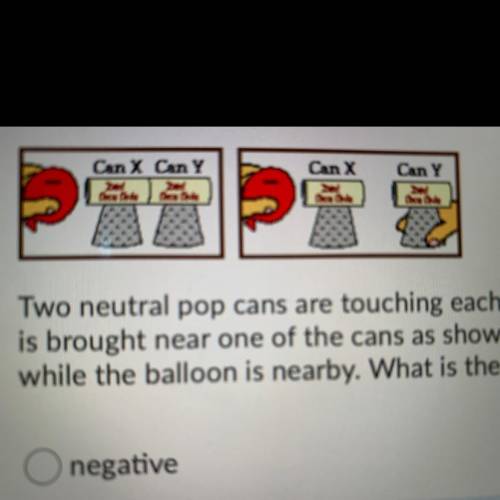
Physics, 15.05.2021 20:00 jociymartinez6214
Two neutral pop cans are touching each other. A negatively charged balloon
is brought near one of the cans as shown above. The cans are separated
while the balloon is nearby. What is the charge of can X? pls hurry NO LINKS!
1. negative
2. positive
3. impossible to tell
4. neutral


Answers: 2


Other questions on the subject: Physics

Physics, 22.06.2019 08:00, JuanTorres7
The arrival of in the early days of europa’s existence could have formed its ocean. it is likely that the water experienced similar to earth. it is also possible that this water is retained beneath europa’s surface and in its atmosphere due to europa’s . 1.) a. precipitation b. water vapor c. icy debris 2.) a. gravitational compression b. biochemical cycling c. radiogenic heating 3.) a, gravity b. magnetic field c. heat energy for plato
Answers: 3

Physics, 22.06.2019 08:50, babas97
The experiment was repeated many years later but the gases were mixed in a different type of container. a white solid was obtained which was xenon fluoride. predict whether you think 1) krypton and 2) radon will react with fluorine. explain reasons for your predictions
Answers: 3


Physics, 22.06.2019 15:00, koranbutterton
Astudent throws a water balloon with speed v0 from a height h = 1.76 m at an angle θ = 21° above the horizontal toward a target on the ground. the target is located a horizontal distance d = 9.5 m from the student’s feet. assume that the balloon moves without air resistance. use a cartesian coordinate system with the origin at the balloon's initial position. (a) what is the position vector, rtarge t, that originates from the balloon's original position and terminates at the target? put this in terms of h and d, and represent it as a vector using i and j. (b) in terms of the variables in the problem, determine the time, t, after the launch it takes the balloon to reach the target. your answer should not include h. (c) create an expression for the balloon's vertical position as a function of time, y(t), in terms of t, vo, g, and θ. (d) determine the magnitude of the balloon's initial velocity, v0, in meters per second, by eliminating t from the previous two expressions.
Answers: 3
You know the right answer?
Two neutral pop cans are touching each other. A negatively charged balloon
is brought near one of t...
Questions in other subjects:



History, 17.10.2019 16:30

Mathematics, 17.10.2019 16:30




Mathematics, 17.10.2019 16:30




